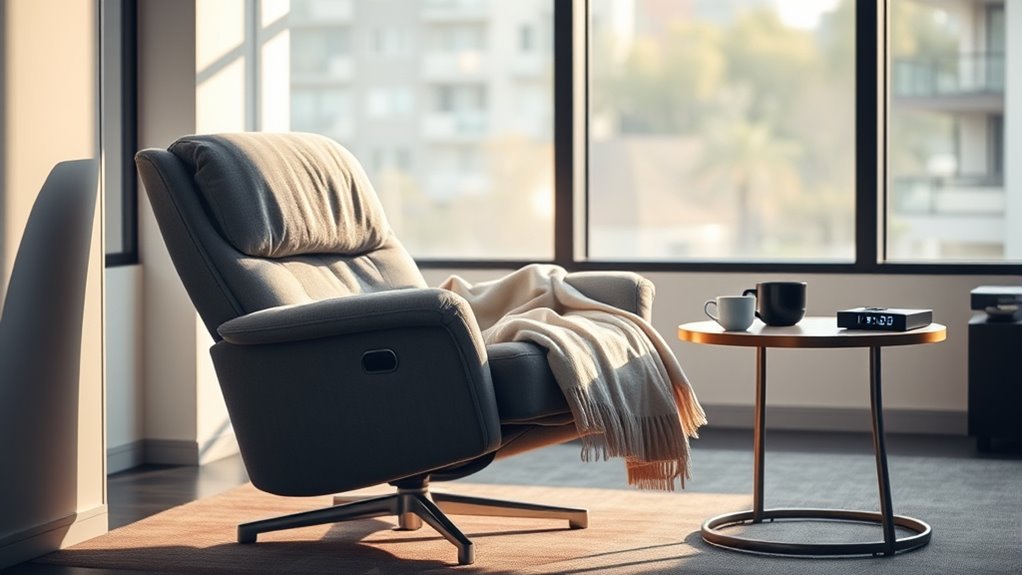Power naps work by tapping into your body’s natural sleep cycles, mainly light sleep stages, which boost alertness and cognitive function without causing grogginess. Keeping naps between 10 to 20 minutes helps you avoid deep sleep, preventing sleep inertia. This quick rest resets your brain, improves mood, and sharpens focus, making you more productive. Understanding how sleep cycles operate can help you maximize these benefits—continue to explore how this simple practice can transform your day.
Key Takeaways
- Power naps engage light sleep stages, preventing deep sleep and sleep inertia, leading to quicker alertness recovery.
- Short naps boost cognitive functions like memory, concentration, and decision-making, enhancing overall productivity.
- Timing naps between 10-20 minutes aligns with natural sleep cycles, maximizing mental refreshment and minimizing grogginess.
- Napping reduces fatigue and irritability, improving mood and emotional stability essential for sustained productivity.
- Scientific research confirms that well-timed power naps optimize alertness and focus, supporting better daily performance.

Power naps have gained popularity as a simple way to boost productivity, but understanding their scientific basis reveals why they actually work. When you take a short nap, you’re tapping into your body’s natural sleep cycles, which play a vital role in how refreshed and alert you feel afterward. Sleep isn’t just about rest; it’s a complex process that follows specific stages, cycling through light sleep, deep sleep, and REM sleep. During a power nap, ideally lasting between 10 to 20 minutes, you’re primarily engaging in light sleep stages, which helps you avoid waking up groggy or disoriented. This is important because waking up from deep sleep can cause sleep inertia, a period of grogginess that hampers your alertness levels. By staying within the lighter stages, you allow your brain to briefly recharge without entering the deep sleep phases that require more time to complete.
Your alertness levels are directly linked to these sleep cycles. As you go about your day, your alertness naturally fluctuates, often dipping during mid-afternoon. A power nap effectively interrupts this dip, giving your brain a quick boost of energy and focus. When you nap for the right amount of time, you allow your brain to consolidate information, clear out fatigue, and reset your mental state. This process enhances your cognitive functions, including memory, concentration, and decision-making skills. What’s more, a short nap can enhance your mood, reducing stress and irritability that often accumulate when you’re sleep-deprived or overworked.
Understanding the science behind sleep cycles also emphasizes the importance of timing your naps correctly. If you nap too long, you risk entering deeper sleep stages, which can lead to grogginess upon waking. Conversely, a brief nap aligns with the lighter sleep stages, providing a quick yet effective mental refresh. It’s these subtle but impactful differences that determine how much you benefit from a power nap. By syncing your nap duration with your sleep cycles, you optimize the boost to your alertness levels, making you more productive when you return to your tasks.
Additionally, incorporating regular power naps into your routine can help establish a consistent sleep pattern, which supports overall health and well-being. In essence, power naps work because they tap into your body’s natural sleep architecture, helping you reset your alertness levels efficiently. When you understand how sleep cycles influence how rested you feel, you can tailor your naps to maximize their benefits. Short, well-timed naps aren’t just a quick fix—they’re a scientifically backed strategy to enhance your focus, mood, and overall productivity throughout the day.
Frequently Asked Questions
Can Power Naps Replace a Full Night’s Sleep Effectively?
Power naps can’t fully replace a full night’s sleep, especially if you’re experiencing sleep deprivation. While a quick nap provides a cognitive boost and helps refresh your mind, it doesn’t offer the deep restorative benefits of a complete sleep cycle. Relying solely on naps might leave you feeling less rested over time. For ideal health and productivity, aim for consistent, quality nighttime sleep alongside strategic power naps.
Are There Specific Times of Day When Power Naps Are Most Beneficial?
Like a well-timed symphony, your body responds best to power naps at specific times. The ideal timing aligns with your circadian rhythms, typically early afternoon, around 1 to 3 p.m. When you nap during these windows, you’re more likely to boost alertness and productivity. Avoid late afternoon naps, as they can disrupt nighttime sleep. Knowing your body’s natural rhythm helps you maximize the benefits of a quick rest.
How Does Individual Sleep Cycle Variation Affect Power Nap Effectiveness?
Your sleep cycle varies due to individual differences, impacting how effective power naps are for you. If you have a shorter sleep cycle, a quick 20-minute nap might leave you refreshed, while longer cycles could require up to 90 minutes to complete a full cycle. Recognizing your unique sleep pattern helps you tailor naps for maximum energy, ensuring you wake up feeling more alert and productive.
What Are the Best Environments for Taking an Effective Power Nap?
Ever wondered where you should nap for maximum refreshment? You should find a comfortable setting with minimal noise and ambient lighting to help you relax fully. Avoid bright lights and noisy environments that can disrupt your rest. Do you really want to wake up feeling groggy? Choosing a quiet, dim space guarantees your power nap is effective, leaving you energized and ready to tackle your day with renewed focus.
Do Power Naps Have Any Negative Effects on Nighttime Sleep Quality?
You might worry that power naps could hurt your nighttime sleep quality, but generally, they don’t if you practice good sleep hygiene. Keep naps short—around 20 minutes—and avoid caffeine before napping. Caffeine consumption later in the day can interfere with your ability to fall asleep at night, so it’s best to limit it. Properly timed power naps can boost your energy without disrupting your sleep schedule.
Conclusion
So, next time you catch yourself feeling sluggish, remember that a quick power nap might just be the coincidence your brain needs. It’s funny how a simple pause can release your focus and boost your productivity, almost like the universe aligning for your benefit. Embrace those moments of rest—they’re not just coincidence but a smart, science-backed way to keep you sharp and energized throughout your day. Sometimes, the best ideas come when you least expect them.










